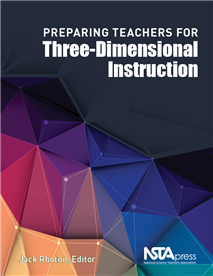All Book Chapters
Book Chapter
State Policies and Regulations for Implementing the NGSS
This chapter, by Stephen L. Pruitt, addresses state policies and regulations that affect the implementation of the Next Generation Science Standards (NGSS). It focuses on the new standards, but also considers state and district policies and how they...
Book Chapter
This chapter, by Norman G. Lederman, Judith S. Lederman, and Selina L. Bartels, reviews the Next Generation Science Standards and then offers examples of elementary science methods teachers can use to apply the NGSS in the classroom. In addition to ...
Book Chapter
This chapter, by Julie A. Luft and Robert Idsardi, shares methods for preparing preservice teachers to uphold the vision of the Next Generation Science Standards (NGSS). We begin by discussing bridging practices related to content, adapting lessons,...
Book Chapter
This chapter, by Ann T. S. Taylor and Joseph W. Shane, discusses ideas for embedding aspects of the Next Generation Science Standards (NGSS) within biology courses that prospective teachers commonly complete at the undergraduate level. We begin by ...
Book Chapter
This chapter, by Sarah B. Boesdorfer, discusses how firsthand experience learning chemistry content, while engaged in science and engineering practices or crosscutting concepts, helps preservice teachers experience the type of instruction they will e...
Book Chapter
This chapter, by Michael A. Gibson, discusses an adaptable instruction activity used in undergraduate Earth science courses with preservice teachers to illustrate the gains in conceptual understanding that result from firsthand data collection and an...
Book Chapter
Challenges in Undergraduate Science Teaching for Prospective Teachers
This chapter, by Jay B. Labov, begins with a focus on the ways in which recent K–12 educational initiatives, such as the Next Generation Science Standards (NGSS) are likely to affect teaching and learning of STEM (science, technology, engineering,...
Book Chapter
Harnessing the Business Community and Other Entities to Support the Vision of the NGSS
This chapter is by Chih-Che Tai, Ryan Nivens, Laura Robertson, Karin Keith, Anant Godbole, and Jack Rhoton....
Book Chapter
The purpose of this assessment probe is to elicit students’ ideas about reflection. The probe is designed to find out if students recognize that all objects we can see reflect some light. The probe is provided in English and Spanish. This book sele...
Book Chapter
The purpose of this assessment probe is to elicit students’ ideas about sound. The probe is designed to reveal whether students recognize that sound is produced by vibrating matter. The probe is provided in English and Spanish. This book selection ...
Book Chapter
The purpose of this assessment probe is to elicit students’ ideas about conservation of matter (or mass). The probe is designed to reveal whether students think matter (or mass) is conserved during a change in state. The probe is provided in Englis...
Book Chapter
The purpose of this assessment probe is to elicit students’ ideas about the physical process of melting. The probe is designed to find out if students recognize melting as a change in state from solid to liquid that involves an interaction between ...
Book Chapter
The purpose of this assessment probe is to elicit students’ ideas about molecules. The probe is designed to uncover whether students recognize that objects, materials, and substances of both a biological and physical nature are made of molecules. T...
Book Chapter
The purpose of this assessment probe is to elicit students’ ideas about gravity. The probe is designed to determine whether students recognize that gravity is a universal force that exists everywhere on Earth and in space, regardless of whether air...
Book Chapter
The purpose of this assessment probe is to elicit students’ ideas about temperature. The probe is designed to find out whether students recognize that non–heat-producing objects exposed to the same ambient conditions will have the same temperatur...



